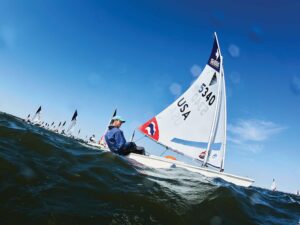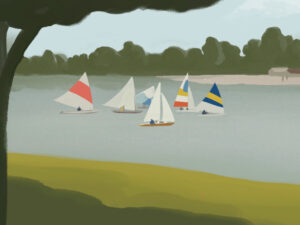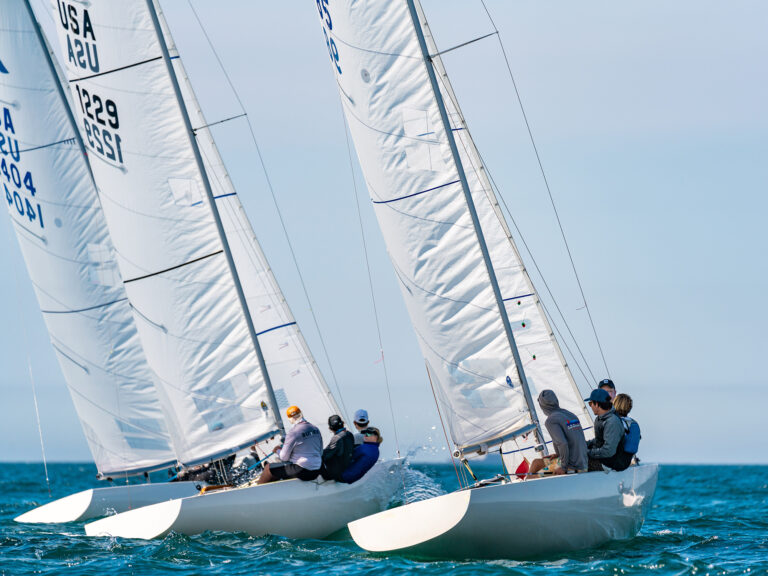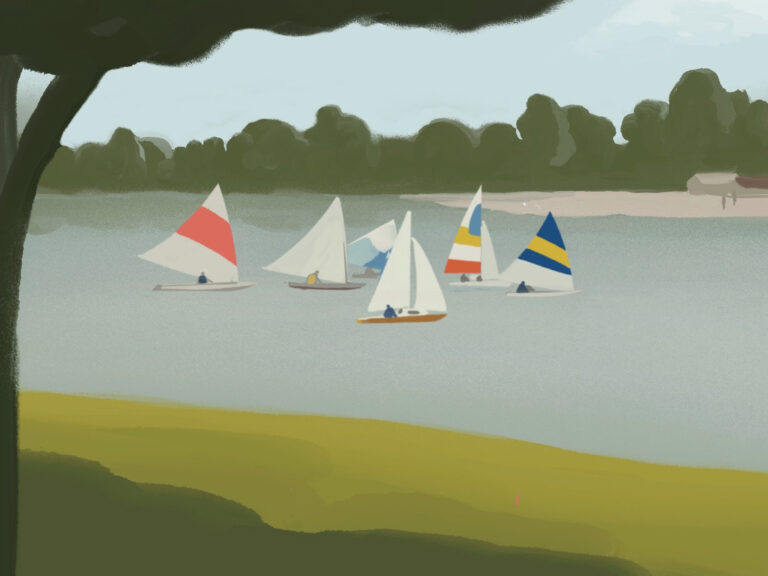Ryan O’Grady, a veteran follower of the Volvo Ocean Race and a top amateur sailor, is providing regular insight and analysis on the 2011-’12 Volvo Ocean Race for SailingWorld.com. To get the full picture of this dynamic race, follow the racing in our Finish Line forum, track the fleet, and catch up on the race with O’Grady’s previous Volvo Voyeur blogs.
We are now 11 days into Leg 2 of the Volvo Ocean Race, and so far it has been one of the most interesting legs in recent memory. I can’t ever remember a leg where each team has been in the lead, and also been in last place. Each position report has seen major shuffling in the pack, and with the Indian Ocean’s doldrums looming, no one has a clear advantage, at least not yet.
At the moment, Groupama appears to be in the favored position as the most easterly boat, sailing higher and faster than its opponents. Puma is in second, playing a “cat and mouse” game with Telefonica.
CAMPER/ ETNZ sits in fourth. Further back, Abu Dhabi Ocean Racing is about 200 miles behind the leader. Team Sanya, which made a bold navigation move to put them into a commanding lead, suffered a rigging failure early in the week and is now docked in Madagascar.
Let’s take a look back at the events of the past week to see how the teams have arrived in their current positions
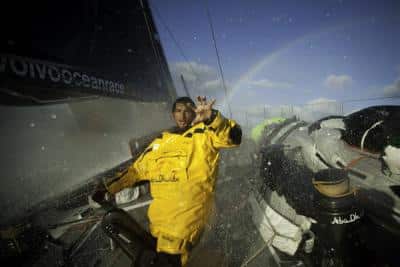
Nick Dana/Abu Dhabi Ocean Racing/Volvo Ocean Race
Stress relief? Adil Khalid onboard Abu Dhabi Ocean Racing
When we last left the fleet, all of the boats were in sight of each other and preparing to cross the Agulhas Current near the Southern tip of Africa. Abu Dhabi’s MCM, Nick Dana shot some great video highlighting the tension of the crew, as they were watching the fleet race round them.
The timing of the cross created the first of many geographic splits of the fleet. Groupama was the first boat to venture across, and then continued to split from the pack, securing a position more south and east than the other boats. Charles Caudrelier, helmsman on Groupama, describes the experience: “We went from light airs to quickly built wind and a very messy sea. As a result, we had to slow the boat. To preserve the boat and the mast, we couldn’t sail at 100 percent. We had waves from every direction, and the boat didn’t stop slamming. A lot of stress on boat, the structure, and the rigging.”
Puma and CAMPER were next to make the move across the current, while Sanya and Abu Dhabi Ocean Racing made the choice to head further north before crossing. Telefonica was the last boat to cross; that move made them the leader of the leg. Navigator Andrew Cape explained the reasoning behind the decision. “I think it’s just a matter of working exactly with the winds you have at the time and making the most of them,” he said. “There’s no super plan, because it just changes so quickly here. You just have to make the best of what [you’ve] got…These things can go either way. Really, it’s a roll of the dice, and you place your bets.”
Unfortunately for those of us watching from our computers, most of the teams crossed the current at night, so there’s no dramatic video of boats breaking, but CAMPER MCM Hamish Hooper did manage to capture the effect of the crossing on a weary crew.
Once free of the Agulhas Current, life didn’t get any easier. Typically, when a fleet makes a large, one side wins and one side loses. For the Volvo fleet, though, this never happened, because the entire fleet sailed into a slow-moving low-pressure front that blocked everyone from the opportunity to enjoy trade-wind sailing to the north. “Sailing events are forever labeling themselves the ‘F1 of sailing,'” says Abu Dhabi Ocean Racing skipper Ian Walker. “But Volvo has taken it a step further by introducing the marine equivalent of the safety car. A cold front extending north-south across the fleet containing rain, little wind, and a 180-degree wind shift is moving slowly east at about 12 knots. Sadly this means that we sail into it at 20 knots, the wind dies, we stop until the front moves forward, and we regain the wind from the old direction. All the time this is happening, those boats behind pile into the back of us whilst we are held up by the ‘weather safety car’…The only real question for navigators and skippers is where to position yourself on the north/south axis in the line up behind the ‘safety car’. If you can get through it fast, then north should be good. If it takes longer, then south could be stronger.”
For the crews on each boat, the constant changes in wind pressure and direction led to five days of non-stop stacking of sails and gear. Each wind shift means tons of sails, food, and gear must be moved from one part of the boat to another down below, while, on deck, crews are putting in and shaking out reefs and changing headsails. Puma skipper Ken Read elaborated on the frustrations this weather situation created. “This is crazy. It’s 100 percent a second start line. It’s been hard and very taxing mentally trying to deal with it all. Each time we sit here and talk about it we make an argument that we would rather be further north or further south. Just a little while [ago] I said to Tom (Addis), ‘We were talking about gybing earlier this morning to get further north, do you remember why?’ and he said, ‘No I don’t remember why anymore.’ So I think it’s going to be very interesting.”
See for yourself from onboard Puma, thanks to MCM Amory Ross.
In a desperate move to break free of the low, Team Sanya made a bold move to the north, hoping to hook up with a large tropical cyclone forming near Madagascar. Moose Sanderson, skipper of Sanya, explained why the team chose to take this risk. “I have been very clear on this from the very start of this campaign,” he said. “We are not fast enough through the water to win this race overall, so we need to take opportunities like this to try to win a leg or get on the podium. We may only get an opportunity like this a few times in the race, where there is a chance to do something different…We will live by the sword or die by the sword so to speak.”
Live by the sword they did. The gamble was soon paying big dividends, and Sanya shot to the top of the leaderboard. But they also died by the sword. Sanya’s chance at victory was dashed when the crew discovered that their rigging had failed at the D2. “The weather was turning for the better, and so we were happy in our decisions and general progress,” said Sanderson. “We had been due to tack an hour earlier in the darkness, but had delayed that given the conditions. For sure, if we had done that, the rig would have fallen over the side. As you can imagine, we are totally gutted and can’t quite believe this has happened when everything was going so well.”
The mast and rigging on Team Sanya is manufactured by Future Fibres, the same company that supplies the mast and rigging to Abu Dhabi Ocean Racing. The D2 failure on Sanya is the same failure that caused Azzam’s mast to explode in Leg 1. While Azzam changed their rigging from Future Fibre’s new continuous carbon rod to discontinuous carbon in Cape Town, Sanya did not. After Sanya’s failure, Future Fibres released a statement. “A full investigation is under way to establish the cause of the diagonal failure,” read the statement, “The CMS lateral rigging system on Sanya Lan is new, state-of-the-art technology, but has been through extensive in-house testing over the last two years. It has also been through an on-the-water testing program in the 12 months leading up to the start of the Volvo Ocean Race. The Sanya Lan rigging was carefully checked in Cape Town prior to the start of this leg.”
Tom Hutchinson, founder of Future Fibres, elaborated. “The plan is to send a team of technicians to meet the boat in Port D’Ehoala, Madagascar, and install a new set of lateral rigging. This is going to involve a great deal of hard work over the Christmas period. We have started production of the cables and parts and are currently working on the logistics of getting the technical team and equipment to Madagascar. However, our priority is to get the boat back in the race as soon as possible.”
At this point, Sanya and crew have arrived in Madagascar to make repairs, but they will be unable to make it to the “secret location” where a ship will take the remainder of the fleet through the pirate zone. This means Moose and his crew will not be competing in the sprint to Abu Dhabi, the Abu Dhabi In-Port Race, or the Leg 3 sprint. As long as Sanya does re-enter the leg and make it to the “secret location,” the team will earn points for finishing Leg 2 and will earn points for the races she missed, though the exact format of how points will be calculated is unknown. Team Sanya will join the fleet for the offshore part of Leg 3 from the “secret location” to her homeport, Sanya, China.
Once Sanya suspended racing, Groupama took over as race leader. Her strategy was to remain the most southerly and easterly boat in the fleet. Once Groupama broke free of the low-pressure front, this positioning put the team on the inside of wind shift, with a better angle and more pressure than its rivals. For Groupama, they now have to extend their lead as much as possible before the doldrums, where once again the fleet will compress, and the leg will start again for the third time. Stay tuned, I guarantee much more action and lead changes to come!


